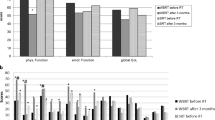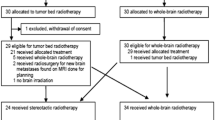Abstract
Purpose
Proton therapy could minimize the risk of side effects and, therefore, reduce the possible detrimental effect on health-related quality of life (HRQOL) of re-irradiation. The aim of this study was to determine the effect of re-irradiation with active scanning proton therapy on recurrent glioblastoma (GBM) in terms of HRQOL scored by the European Organization for Research and Treatment of Cancer Quality of Life Questionnaire (EORTC QLQ)-C30 and EORTC Quality of Life Questionnaire Brain Cancer Module (QLQ-BN20).
Methods
Thirty-three patients with recurrent GBM were re-irradiated with active scanning proton therapy. Subscales within the EORTC QLQ-C30 include five functional scales, six single-item scales, and global QoL. The BN20 assessed visual disorders, motor function, communication deficit, various disease symptoms, treatment, toxicity, and future uncertainty. The patients completed the questionnaires before starting proton therapy, the last day of proton therapy, and at every follow-up visit until progression of disease.
Results
The treatment was associated with improvement or stability in most of the preselected HRQOL domains. Global health improved over time with a maximum difference of six points between baseline and 3-months follow-up. Social functioning and motor dysfunction improved over time with a maximum difference of eight and two points, respectively. We showed a non-significant decrease in cognitive and emotional functioning. Fatigue remained stable during the analysis such as the other preselected domains.
Conclusions
Re-irradiation with proton therapy is a safe and effective treatment in patients with recurrent glioblastoma. Proton therapy does not negatively effect on HRQOL, but rather it seems to preserve HRQOL until the time of disease progression.

Similar content being viewed by others

References
Aaronson NK, Ahmedzai S, Bergman B et al (1993) The European Organization for Research and Treatment of Cancer QLQ-C30: a quality of life instrument for use in international clinical trials in oncology. J Natl Cancer Inst 85:365–376
Amelio D, Amichetti M (2012) Radiation therapy for the treatment of recurrent glioblastoma: an overview. Cancers (Basel) 4(1):257–280
Aprile I, Chiesa S, Padua L (2015) Occurrence and predictors of the fatigue in high-grade glioma patients. Neurol Sci 36:1363–1369
Bitterlich C, Vordermark D (2017) Analysis of health-related quality of life in patients with brain tumors prior and subsequent to radiotherapy. Oncol Lett 14(2):1841–1846
Central Brain Tumor Registry of the United States (CBTRUS) (2010) Statistical report: primary brain and central nervous system tumors diagnosed in the United States in 2004–2007. https://www.cbtrus.org. Accessed 20 Mar 2020
Ernst-Stecken A, Ganslandt O, Lambrecht U, Sauer R, Grabenbauer G (2007) Survival and quality of life after hypofractionated stereotactic radiotherapy for recurrent malignant glioma. J Neurooncol 81(3):287–294
Fayers PM, Aaronson NK, Bjordal K et al (2001) European Organization for Research and Treatment of Cancer QLQ-C30 scoring manual, 3rd edn. EORTC, Brussels
Galle J, McDonald M, Simoneaux V, Buchsbaum J (2015) Reirradiation with proton therapy for recurrent gliomas. Int J Part Ther 2(1):11–18
Hahn CA, Dunn RH, Logue PE, King JH, Edwards CL, Halperin EC (2003) Prospective study of neuropsychologic testing and quality-of life assessment of adults with primary malignant brain tumors. IJROBP 55(4):992–999
Kazmi F, Soon YY, Leong YH, Koh WY, Vellayappan B (2019) Re-irradiation for recurrent glioblastoma (GBM): a systematic review and meta-analysis. J Neurooncol 142(1):79–90
Koshy M, Villano JL, Dolecek TA et al (2012) Improved survival time trends for glioblastoma using the SEER 17 population-based registries. J Neurooncol 107:207–212
Litofsky NS, Farace E, Anderson F Jr, Meyers CA, Huang W, Laws ER Jr (2004) Glioma Outcomes Project Investigators. Depression in patients with highgrade glioma: results of the Glioma Outcomes Project. Neurosurgery 54(2):358–366
Lupien SJ, Gillin CJ, Hauger RL (1999) Working memory is more sensitive than declarative memory to the acute effects of corticosteroids: a dose-response study in humans. Behav Neurosci 113(3):420–430
Mainio A, Tuunanen S, Hakko H, Niemela A, Koivukangas J, Rasanen P (2006) Decreased quality of life and depression as predictors for shorter survival among patients with low-grade gliomas: a follow-up from 1990 to 2003. Eur Arch Psychiatry Clin Neurosci 256(8):516–521
Minniti G, Amelio D, Amichetti M et al (2010) Patterns of failure and comparison of different target volume delineations in patients with glioblastoma treated with conformal radiotherapy plus concomitant and adjuvant temozolomide. Radiother Oncol 97:377–438
Minniti G, Scaringi C, Baldoni A et al (2013) Health-related quality of life in elderly patients with newly diagnosed glioblastoma treated with short-course radiation therapy plus concomitant and adjuvant temozolomide. Int J Radiat Oncol Biol Phys 86(2):285–291
Mizumoto M, Okumura T, Ishikawa E et al (2013) Reirradiation for recurrent malignant brain tumor with radiotherapy or proton beam therapy. Technical considerations based on experience at a single institution. Strahlenther Onkol 189(8):656–663
Navarria P, Minniti G, Clerici E et al (2019) Re-irradiation for recurrent glioma: outcome evaluation, toxicity and prognostic factors assessment. A multicenter study of the Radiation Oncology Italian Association (AIRO). J Neurooncol 142(1):59–67
Neider C, Nestle U, Niewald M, Walter K, Schnabel K (1999) Hyperfractionated reirradiation for malignant glioma. Front Radiat Ther Oncol 33:150–157
Osoba D, Rodrigues G, Myles J, Zee B, Pater J (1998) Interpreting the significance of changes in health-related quality-of-life scores. J Clin Oncol 16(1):139–144
Pinheiro J, Bates D, DebRoy S, Sarkar D, R Core Team (2016) nlme: linear and nonlinear mixed effects models. R package version 3.1-128. https://CRAN.R-project.org/package=nlme. Accessed 20 Mar 2020
R Core Team (2016) R: a language and environment for statistical computing. R Foundation for Statistical Computing, Vienna. https://www.R-project.org. Accessed 20 Mar 2020
Ryu S, Buatti JM, Morris A, Kalkanis SN, Ryken TC, Olson JJ (2014) AANS/CNS Joint Guidelines Committee the role of radiotherapy in the management of progressive glioblastoma: systematic review and evidence-based clinical practice guideline. J Neurooncol 118(3):489–499
Scartoni D, Amelio D, Farace P, Widesott L, Fellin F, Giacomelli I, Schwarz M, Amichetti M (2018a) Health related quality of life in patients with recurrence glioblastoma treated with active beam protontherapy. https://www.congressiairo.it/2018/Rimini_files/AIRO%202018%20abstract%20book.pdf. Accessed 20 Mar 2020
Scartoni D, Amelio D, Giacomelli I, Amichetti M (2018b) Health related quality of life in recurrent glioblastoma treated with re-irradiation with active scanning protontherapy. Neuro-Oncology 20(Suppl_3):iii250
Scartoni D, Amelio D, Farace P, Widesott L, Fellin F, Giacomelli I, Schwarz M, Amichetti M (2018c) Health related quality of life in large recurrence glioblastoma treated with active beam protontherapy. Radiother Oncol 133:S690 (April 2019)
Scoccianti S, Francolini G, Carta GA et al (2018) Re-irradiation as salvage treatment in recurrent glioblastoma: a comprehensive literature review to provide practical answers to frequently asked questions. Crit Rev Oncol Hematol 126:80–91
Taphoorn MJ, Stupp R, Coens C et al (2005) Health-related quality of life in patients with glioblastoma: a randomised controlled trial. Lancet Oncol 6(12):937–944
Taphoorn MJ, Claassens L, Aaronson NK et al (2010a) An international validation study of the EORTC brain cancer module (EORTC QLQ-BN20) for assessing health-related quality of life and symptoms in brain cancer patients. Eur J Cancer 46:1033–1040
Taphoorn MJ, Sizoo EM, Bottomley A (2010b) Review on quality of life issues in patients with primary brain tumors. Oncologist 15:618–626
Walker M, Brown J, Brown K et al (2003) Practical problems with the collection and interpretation of serial quality of life assessments in patients with malignant glioma. J Neurooncol 63(2):179–186
Wick W, Fricke H, Junge K et al (2014) A phase II, randomized, study of weekly APG101 + reirradiation versus reirradiation in progressive glioblastoma. Clin Cancer Res 20(24):6304–6313
Young AH, Sahakian BJ, Robbins TW, Cowen PJ (1999) The effects of chronic administration of hydrocortisone on cognitive function in normal male volunteers. Psychopharmacology 145(3):260–266
Author information
Authors and Affiliations
Contributions
All authors contributed to the study conception and design. Material preparation, data collection, and analysis were performed by DS, DA, and IG. The first draft of the manuscript was written by DS and all authors commented on previous versions of the manuscript. All authors read and approved the final manuscript.
Corresponding author
Ethics declarations
Conflict of interest
There are no conflict of interest disclosures from any authors.
Ethical approval
All procedures performed in studies involving human participants were in accordance with the ethical standards of the institutional and/or national research committee and with the 1964 Helsinki declaration and its later amendments or comparable ethical standards.
Informed consent
Informed consent was obtained from all individual participants included in the study.
Research involving human and animal participants
This article does not contain any studies with animals performed by any of the authors.
Additional information
Publisher's Note
Springer Nature remains neutral with regard to jurisdictional claims in published maps and institutional affiliations.
Rights and permissions
About this article
Cite this article
Scartoni, D., Amelio, D., Palumbo, P. et al. Proton therapy re-irradiation preserves health-related quality of life in large recurrent glioblastoma. J Cancer Res Clin Oncol 146, 1615–1622 (2020). https://doi.org/10.1007/s00432-020-03187-w
Received:
Accepted:
Published:
Issue Date:
DOI: https://doi.org/10.1007/s00432-020-03187-w



